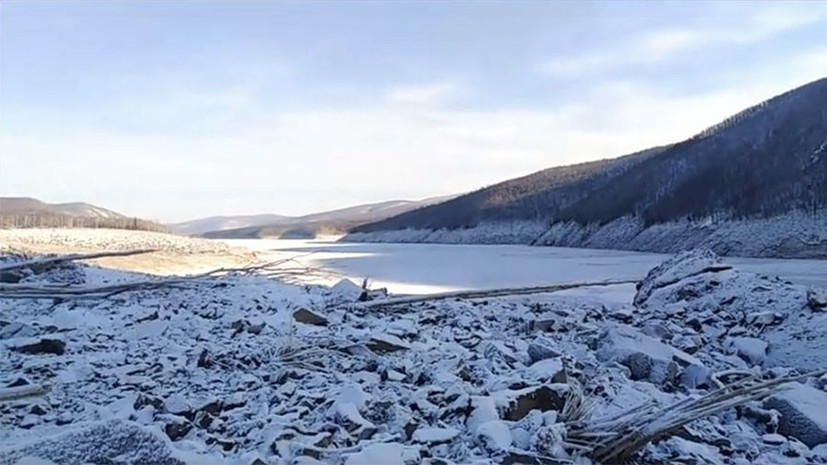The analysis of satellite data allowed scientists to identify a thermal anomaly in the region of the overlap of the channel of the Bureya River in the Verkhnebureinsky district of the Khabarovsk Territory. This is stated on the website of the FSUE "Scientific Research Center for Space Hydrometeorology" Planet ".
The specialists of the center made their conclusion on the basis of the multi-temporal data of the Earth remote sensing satellite Sentinel-2A for December 9 and 12. Scientists have identified significant landscape changes that occurred in this time period near the channel of the river Bureya, above the reservoir. In particular, the upper part of the hill is missing in the photo of December 12.
“The absence can be judged by a clear, close to rectangular, darker contour: a darker tone indicates that the area enclosed in the contour is lower because it is less illuminated by the Sun than the surrounding hills. Also in the December 9 photo, the shadow of this hill has a completely different outline, ”the message says.
In addition, there is a change in the land cover. So, on the completely frozen river bed there is water. Scientists believe that ice could have been deformed under the influence of rocks.
“An additional analysis of the ten-minute images of the Himawari-8 spacecraft revealed a thermal anomaly in the area that occurred on December 12 at 9:50 local time (December 11, 23:50 GMT),” the Planet Research and Development Center website says.
The information received was promptly transferred to units of Roshydromet, the Emergencies Ministry of Russia, the administration of the presidential plenipotentiary in the Far Eastern Federal District, to the government of the Khabarovsk Territory, to RusHydro and to the Amur Water Basin Department.
On the eve of the media of the Khabarovsk Territory, information appeared that a meteorite allegedly fell in the area of the Bureya riverbed in the Khabarovsk Territory. As a result of the incident, the hill was destroyed, the ground blocked the river bed.
However, the head of the Sakhalin branch of the Unified Geophysical Service RAS Yuri Levin did not confirm this data. According to him, seismic sensors would reveal the impact of a celestial body on the earth.
At the same time, the company "RusHydro" reported that the expedition of power engineers had already visited the site of the dam and made sure that the river was almost completely blocked as a result of a landslide.
“The water in the reservoir is still sufficient to provide the required amount of electricity. The overlapping of the river by a rock mass, which was formed in a remote area about 100 km above the hydroelectric station, currently does not affect the operation of the station, ”explained the company.
Hydropower specialists are calculating options for the operation of the power plant, based on various scenarios for eliminating blockage in the mainstream.
To gallery page
The head of the Gradient Center for Geophysical Forecasting Laboratory, Viktor Bokov, in a conversation with RT, also doubted that the fall of the mound could have happened as a result of a meteorite falling.
“Most likely, this is really due to the fact that sometimes occurrence of some voids in the crust under the influence of the transfer of large amounts of groundwater. It is possible that they could affect.
When the water dries up, because the summer was still hot, voids are formed, and as a result some of the soil can fall through them. And there are really thermal anomalies there, but again it is difficult for me to say as long as we do not have measurements, ”he noted.
In turn, the chief researcher of the Institute of Earthquake Prediction Theory and Mathematical Geophysics of the Russian Academy of Sciences Peter Shebalin believes that significant differences in day and night temperatures could be a prerequisite for a spontaneous landslide.
“Since there was neither a meteorite, nor an earthquake - serious shocks were not recorded by the seismic stations, then it was a spontaneous collapse. Thermal exposure is one of the possible mechanisms for accelerating this process, but still thermal processes are rather slow. Of course, daily fluctuations in temperature, if they are very large, can affect, because the rock material expands with increasing temperature and shrinks with decreasing, thereby creating cracks. It remained a little more to push, so that finally could slip. This, of course, could be loosened by daily fluctuations in temperature, if they were very large, ”the expert emphasized in an interview with RT.
The site survey was also conducted by a working group consisting of representatives of the administration of the village of Chekunda of the Verkhnebureinsky district, rescuers of the local search and rescue squad, as well as specialists of the Bureyskaya hydroelectric power station in the Amur region. Along with this, it is emphasized that the situation is under the control of the Crisis Management Center of the Main Department of the EMERCOM of Russia for the Khabarovsk Territory.
“On December 25, 2018, an inspection of the dumping ground is scheduled by an interdepartmental commission with representatives of interested departments, including the EMERCOM of Russia. After assessing the situation, the specialists will decide on further necessary measures, ”the ministry said.

